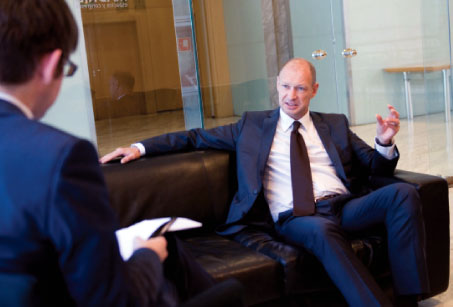
Lammers: “It was no secret that Malév had been weak for several years, especially during the winter season. So when it happened, we were well prepared to immediately get in touch with other business partners – both existing and new.”
The past 8 years have rarely been dull for Budapest Airport. Hungary’s accession to the EU in 2004 had a significantly positive impact on the country’s economic development, then the government sought to privatise the airport operating concession, eventually agreeing to sell the 75-year concession to BAA for €1.9 billion. While BAA’s flirtation with the company in 2006 was brief, Hochtief subsequently took it on and increased its interest in the airport to 49.9% last year. The remainder is held by four financial investors.
Today, Budapest is a major cultural and business centre of a country of 10 million people, with a developed, robust market economy.
The airport handled a record 8.9 million passengers in 2011, but on 3 February 2012, the year took a traumatic turn when its biggest customer and hub operator, Malév, ceased operations. Faced with such a difficult situation, the bounce back to date has been impressive, with the airport having already managed to recover over 80% of its point-to-point traffic.
The grounding of national carrier Malév, after nearly 66 years of service, naturally forced Budapest Airport to severely adjust its operations. Cost-cutting measures included making 250 employees (20% of the workforce) redundant, while Terminal 1 was closed in May and all operations moved to Terminal 2.
However, the airport has moved into the post-Malév era with notable optimism, and in particular a swift response and recovery of point-to-point traffic. Malév accounted for around 40% of Budapest’s passenger traffic and air traffic movements. Significantly, it was also the only carrier operating the hub and spoke model; 20% of total passengers and 40% of Malév’s passengers were transferring at Budapest and that transfer product was gone overnight.
“It was no secret that Malév had been weak for several years, especially during the winter season. So when it happened, we were well prepared to immediately get in touch with other business partners – both existing and new,” commented Lammers. “The level of immediate interest was even beyond our expectations and clearly demonstrates the market potential of our airport. Thankfully, it was still at an early stage before the summer schedule, so some airlines could still arrange plans to refocus capacity – that helped us a lot.”
Lufthansa was the first carrier to step in, launching new services from Berlin and Hamburg on 6 February. In the days following the Malév collapse, several carriers announced new services from Budapest, including Air Berlin, Aegean, Ryanair, Smart Wings and Wizz Air. Importantly, Ryanair established a base at Budapest on 17 February with 5 based aircraft and 30 new routes. “It was initially our plan to recover 75% of point-to-point traffic within the first 6-12 months. We are very optimistic from what we have seen during the summer and we are already beyond 80%, which is very positive,” explained Lammers.
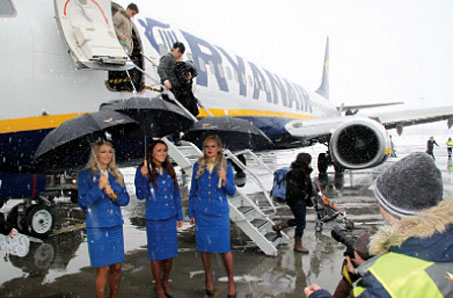
Ryanair established a base at Budapest on 17 February with 5 based aircraft and 30 new routes, and is now the airport’s biggest customer in terms of passenger numbers.
The airport has seen the proportion of low-cost traffic double in the wake of the Malév bankruptcy. In 2011, low-cost carriers accounted for 26% of passenger numbers; this year they will account for something over 50%. Wizz Air, now the airport’s biggest customer, has based a sixth aircraft in Budapest and opened 10 new routes, taking the total to 33. Wizz Air has recently obtained two of the regulated ex-Malév routes, starting new flights to Kiev and Tel Aviv from December. Asked whether the proportion of low-cost traffic would increase further, Lammers replies genially “That will be the exciting question for the months to come. At the moment there is a stable balance, which we are quite happy with as it gives us the full range of products for our passengers.”
While these encouraging developments have put Budapest firmly on the road to recovering point-to-point traffic, the loss of 1.5 million annual transfer passengers and the income generated by them has created a very difficult financial situation for the airport. “Of course, what is hurting most still is the lack of a transfer product. That is something as a top priority on our list, as well as the long haul traffic that was lost with the cancellation of American Airlines services to New York, and the loss of Hainan Airlines to Beijing,” said Lammers. “Malév and American Airlines were both members of the oneworld alliance, so the feed that came from the Malév flights was also important for the American Airlines flights. This is harder to recover, it takes more time, but we are working on this very strongly with existing and new partners and we hope to see some successes for next year.”
Incentives package

Lammers: “It was initially our plan to recover 75% of point-to-point traffic within the first 6-12 months. We are very optimistic from what we have seen during the summer and we are already beyond 80%, which is very positive.”
The attractive incentives package offered by Budapest Airport has been vital in aiding its recovery. Under the scheme, which was introduced several years prior to the Malév collapse, airlines launching new routes could benefit from reduced landing fees for up to five years. For new long haul services, there is a 100% reduction in years 1 and 2, a 75% reduction in year 3, a 50% reduction in year 4, and a 25% reduction in year 5. For new short haul services, the discount in year 1 is 100%, year 2 – 75%, year 3 – 50%, year 4 – 25%, and year 5 – 10%. There is, additionally, a two-year route recovery incentive for airlines starting routes recently terminated by others. The discount in year 1 is 75% and in year 2 is 50%.
Lammers explained: “After privatisation, we made the strategic decision to focus on the business growth and introduced a detailed incentive scheme, which remains attractive in the current situation. We have very much seen success with this.”
The airport also works alongside its partners and national tourism authorities to promote routes and help stimulate growth.
A key strategic objective is to increase long haul connectivity. Qatar Airways launched a direct daily service between Doha and Budapest in September 2011. Services were initially introduced last January with a stopover in Bucharest, with the stopover dropped as it became clear that the aircraft could be filled on the direct route. The service has, since May, been enhanced with an onward connection to Zagreb, which is an important commercial link for Hungary. “We hope these additional volumes might bring additional flight frequencies from Qatar or even a wide-body operation, because at the moment it’s operated with an A321. It’s a very positive development and we want to build on this and see this as a very positive example,” commented Lammers.
Securing a direct service to the US is a priority, with New York JFK a target. The recommencement of services to China is another; Hainan Airlines suspended its services between Beijing and Budapest in February. Lammers would also like to see more flexibility in the bilateral agreements with Russia, Turkey, Israel and Ukraine, where significant demand exists following the demise of Malév. The bilateral agreements stipulate that one carrier from each country may operate services between the two on a reciprocal basis. With the collapse of Malév, Budapest Airport urged the Hungarian Ministry of National Development and the Hungarian CAA to nominate a successor airline to replace Malév. Of these routes, Kiev and Tel Aviv were awarded to Wizz Air in September with flights starting as of December. There is no news yet on the Istanbul and Moscow routes.
Relocation to Terminal 2
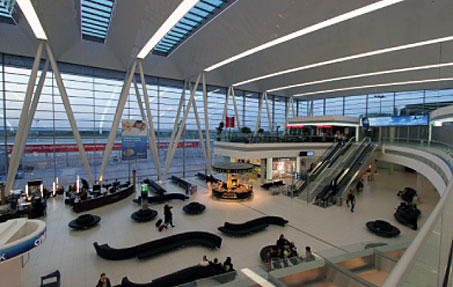
The €102 million SkyCourt, which opened in March 2011, is at the heart of the airport’s modernisation programme. SkyCourt is a centrally located building linking Terminals 2A and 2B, which increased the capacity of Terminal 2 from 5 million passengers per year to 8.5 million.
All airlines were relocated to Terminal 2 in May following the closure of Terminal 1. The airport decided to close Terminal 1, previously used by the low-cost carriers, as part of its efficiency drive following the demise of Malév. The overnight relocation went smoothly and the move was supported by the airport’s partners. Budapest Airport worked with its retail partners, jointly conducting marketing campaigns designed to increase shopping in travel retail outlets. These efforts also included a discount coupon campaign to direct departing passengers to the food court.
The reopening of Terminal 1 remains a possibility in the future, but is not foreseen in the next few years. Should traffic growth necessitate further expansion, it may be that Terminal 2 is instead expanded. “It’s a fantastic location – a midfield terminal between our two fully independent runways. We will keep it flexible; we have both options – reopening Terminal 1 or expanding Terminal 2. Terminal 1 is still being used currently for the airport company offices. We could restart operations in Terminal 1 within a week if needed,” explained Lammers.
Budapest Airport Factbox
Annual passengers: 8.9m (2011), 8.2m (2012 forecast)
Key airline customers: Ryanair (25%), Wizz Air (19%), Lufthansa (11%)
Number of destinations served: 96 (2011), 87 (2012)
Ratio of Legacy v LCC carriers: 46% legacy / 53% LCC
Number of employees: 1,000
Meanwhile, the land tax rules were modified in March, meaning the airport faces an extraordinary 230% annual increase. The news couldn’t have come at a worse time for the airport – just a month after the collapse of the national carrier. The disproportionately high tax has merely served to exacerbate pressure on the airport and further damage the competitiveness of the Hungarian economy and of Budapest in the region.
“To close Terminal 1 was a reasonable thing to do anyhow to reduce our costs after the Malév bankruptcy, but this crazy additional tax is burdening us with an additional €6-8 million – to give some perspective, that is 12-15% of our annual operating expenditure today. On top of a situation in which we had just lost 50% of our business, it is just a disaster,” said Lammers.
Budapest Airport has since submitted a petition to the Constitutional Court of Hungary, arguing that the sudden increase in local land tax violates constitutional principles.
BUD Future project
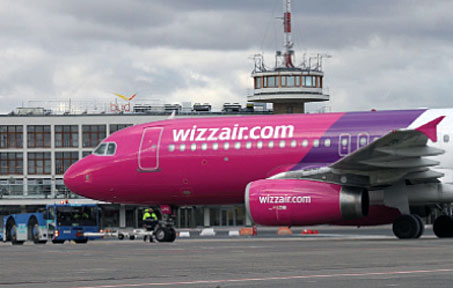
Wizz Air has based a sixth aircraft in Budapest and opened 10 new routes, taking the total to 33. The airline has recently obtained two of the regulated ex-Malév routes, starting new flights to Kiev and Tel Aviv from December.
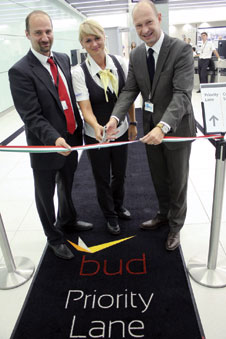
Budapest Airport has introduced special Fast Track Lanes, which enable passengers to choose between the normal security procedure and a priority lane.
Budapest Airport’s overriding strategic aim remains to be the leading airport in Central and Eastern Europe, and the €261 million BUD Future modernisation and expansion programme, which was completed in 2011, is central to strengthening its competitiveness. The €102 million SkyCourt, which opened in March 2011, is at the heart of this modernisation. SkyCourt is a centrally located building linking Terminals 2A and 2B, which increased the capacity of Terminal 2 from 5 million passengers per year to 8.5 million. “We define the best airport in terms of the quality of services, the efficiency and the commercial success. We made a huge step forward when we opened SkyCourt last year. We have had a fantastic uplift in our ASQ ratings, which we monitor every quarter,” explained Lammers.
As part of its efforts to enhance the passenger experience on the ground, Budapest Airport introduced special Fast Track Lanes in July, which enable passengers to choose between the normal security procedure and a priority lane. The Fast Track Lane is available to any eligible premium passengers nominated by their airline in advance; economy class and LCC passengers can also use it by pre-purchasing the product or visiting one of the sales points in the terminal. “Budapest Airport had to respond to the change in airline mix and changes in passengers’ travelling customs – this is the main reason why we have decided to introduce the Fast Track Lane services. It’s about giving passengers the choice. We have had very positive feedback on the service,” said Lammers.
One-bag rule
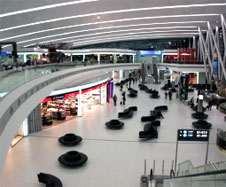
All airlines were relocated to Terminal 2 in May following the closure of Terminal 1. The airport decided to close Terminal 1, previously used by the low-cost carriers, as part of its efficiency drive following the demise of Malév.
On top of the various challenges the airport faces, the so-called one-bag rule being implemented by some low-cost carriers remains the single biggest threat to its commercial revenues. As with many airports, it is an issue that has created uncertainty and confusion among passengers. Budapest Airport has sought to work with its retail partners to introduce large bags in an effort to help passengers fit everything into one bag, but the core problem remains. “It doesn’t make sense if carriers on the one hand demand that aeronautical charges be reduced arguing that we have such a fantastic non-aeronautical business, but they are blocking, or limiting these opportunities on the other hand, through the one-bag rule. It is an important issue that counts as much in terms of passenger experience as commercial revenues,” asserted Lammers.
Environmental strategy
Budapest Airport is Airport Carbon Accredited at the ‘Mapping’ level under ACI EUROPE’s institutionally endorsed programme, gaining the recognition during the Hungarian Presidency of the EU in the first half of 2011. The airport has a strong commitment to environmental sustainability, and in 2007 launched an energy rationalisation programme, which saw it renovate airfield ground lighting systems, install solar panels on the roof of Terminal 1 and significantly reduce its gas consumption. Lammers commented: “We are very much focused on environmental initiatives. Reducing consumption of utilities is a priority. From the very beginning, after the privatisation, Budapest Airport, as part of the HOCHTIEF AirPort group, decided to give high attention to the environment. We undertook a voluntary noise insulation programme around the airport, and we undertook noise zoning, which was not an official requirement, to demonstrate that the airport is a good neighbour and that these issues are important to us.”
Road to recovery
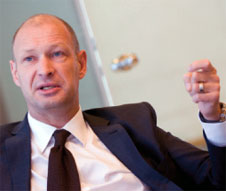
Lammers: “We define the best airport in terms of the quality of services, the efficiency and the commercial success. We made a huge step up when we opened SkyCourt last year. We have had a fantastic uplift in our ASQ ratings, which we monitor every quarter.”
While Budapest Airport faced a challenging start to the year, it is business as usual moving into the final quarter of 2012. Lammers poignantly says that “a new life started for us on 4 February”. The airport was well prepared and strong support from its airline partners means 80% of point-to-point traffic has already been recovered. Budapest Airport is looking to the future with significant optimism and with growth accelerating, is now looking to expand its network with more long haul routes, capitalising on the undoubted untapped market potential of the gateway to Hungary.







